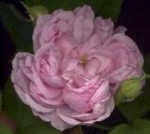 If your looking for something a little bit different, take a look at moss roses. Their sepals, calyces, and pedicels are covered with a growth that looks like moss. This growth is actually prickles and oil glands that have been modified by natural mutation mutation. It is is sticky, hard to the touch, has a piney fragrance when touched and gives a unique look especially when the plant is in bud.
If your looking for something a little bit different, take a look at moss roses. Their sepals, calyces, and pedicels are covered with a growth that looks like moss. This growth is actually prickles and oil glands that have been modified by natural mutation mutation. It is is sticky, hard to the touch, has a piney fragrance when touched and gives a unique look especially when the plant is in bud.
 The mossy growth first appeared as the result of mutations in Centifolia roses about 300 years ago. Further mutations and interbreeding with Damask roses have further enhanced moss roses and increased their variability. The Victorians who were especially fond of oddities especially enjoyed moss roses and most were bred from 1850 to 1870. They are difficult to find in the trade now partially due to propagation problems.
The mossy growth first appeared as the result of mutations in Centifolia roses about 300 years ago. Further mutations and interbreeding with Damask roses have further enhanced moss roses and increased their variability. The Victorians who were especially fond of oddities especially enjoyed moss roses and most were bred from 1850 to 1870. They are difficult to find in the trade now partially due to propagation problems.
Most moss roses are pink, with some being white, red or mauve and at least one being yellow. They tend to be very fragrant, andprickly. Older ones are once blooming although newer ones with more Damask in their background are more likely to repeat bloom.
Flower Size: 2.5-4”
Petal Number: Double (17-25) to very full (41+)
Flower Form: Flat, open, sometimes quartered and/or with button
Flower Substance: Medium
Flowering: Most bloom once in the spring; newer hybrids are repeat bloomers
Fragrance: Fragrant to very fragrant
Stem:Usually stiff upright stems bear flowers singly or in clusters; stems can be lax.
Size of Bush: 3-6’
Disease Resistance: Good
Hardiness: Zone 5
Some popular moss roses are:
 ‘Salet’: free-blooming rose pink flowers, with pale soft leaves on 5’ bush
‘Salet’: free-blooming rose pink flowers, with pale soft leaves on 5’ bush
 ‘Alfred de Dalmas’: flesh pink flowers on short leafy stems of 4’ bush fade to white; not vigorous but repeats
‘Alfred de Dalmas’: flesh pink flowers on short leafy stems of 4’ bush fade to white; not vigorous but repeats
 ‘William Lobb’ Once blooming, very tall (8+’) vigorous with crimsonflowers aging to purple, magenta, lilac and gray.
‘William Lobb’ Once blooming, very tall (8+’) vigorous with crimsonflowers aging to purple, magenta, lilac and gray.
